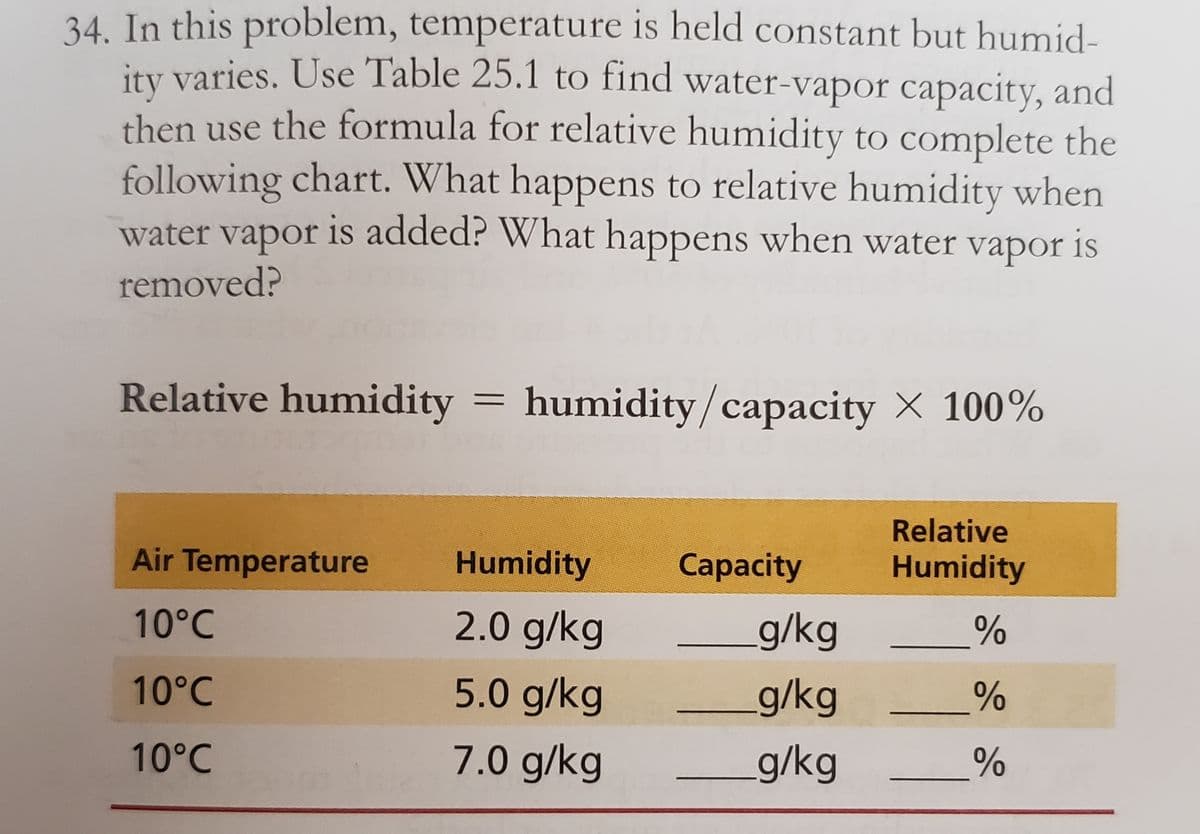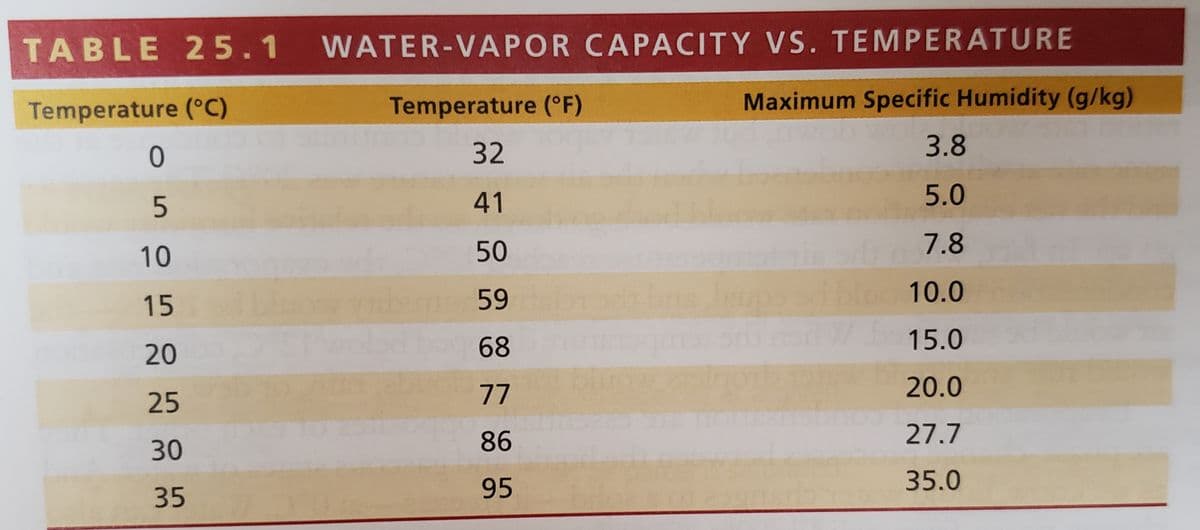In this problem, temperature is held constant but humidity varies. Use table 25.1 to find water vapor capacity and then use the formula for relative humidity to complete the following chart. What happens to relative humidity when water vapor is added? What happens when water vapor is removed? Relative humidity = humidity/capacity x 100%
In this problem, temperature is held constant but humidity varies. Use table 25.1 to find water vapor capacity and then use the formula for relative humidity to complete the following chart. What happens to relative humidity when water vapor is added? What happens when water vapor is removed? Relative humidity = humidity/capacity x 100%
Applications and Investigations in Earth Science (9th Edition)
9th Edition
ISBN:9780134746241
Author:Edward J. Tarbuck, Frederick K. Lutgens, Dennis G. Tasa
Publisher:Edward J. Tarbuck, Frederick K. Lutgens, Dennis G. Tasa
Chapter1: The Study Of Minerals
Section: Chapter Questions
Problem 1LR
Related questions
Question
In this problem, temperature is held constant but humidity varies. Use table 25.1 to find water vapor capacity and then use the formula for relative humidity to complete the following chart. What happens to relative humidity when water vapor is added? What happens when water vapor is removed?
Relative humidity = humidity/capacity x 100%

Transcribed Image Text:34. In this problem, temperature is held constant but humid-
ity varies. Use Table 25.1 to find water-vapor capacity, and
then use the formula for relative humidity to complete the
following chart. What happens to relative humidity when
water vapor is added? What happens when water vapor is
removed?
Relative humidity = humidity/capacity X 100%
Relative
Air Temperature
Humidity
Capacity
Humidity
10°C
2.0 g/kg
g/kg
10°C
5.0 g/kg
g/kg
10°C
7.0 g/kg
g/kg

Transcribed Image Text:TABLE 25.1 WATER-VAPOR CAPACITY VS. TEMPERATURE
Temperature (°C)
Temperature (°F)
Maximum Specific Humidity (g/kg)
32
3.8
41
5.0
10
50
7.8
59
loo10.0
15
68
15.0
20
77
20.0
25
86
27.7
30
95
35.0
35
Expert Solution
This question has been solved!
Explore an expertly crafted, step-by-step solution for a thorough understanding of key concepts.
This is a popular solution!
Trending now
This is a popular solution!
Step by step
Solved in 2 steps

Recommended textbooks for you

Applications and Investigations in Earth Science …
Earth Science
ISBN:
9780134746241
Author:
Edward J. Tarbuck, Frederick K. Lutgens, Dennis G. Tasa
Publisher:
PEARSON

Exercises for Weather & Climate (9th Edition)
Earth Science
ISBN:
9780134041360
Author:
Greg Carbone
Publisher:
PEARSON

Environmental Science
Earth Science
ISBN:
9781260153125
Author:
William P Cunningham Prof., Mary Ann Cunningham Professor
Publisher:
McGraw-Hill Education

Applications and Investigations in Earth Science …
Earth Science
ISBN:
9780134746241
Author:
Edward J. Tarbuck, Frederick K. Lutgens, Dennis G. Tasa
Publisher:
PEARSON

Exercises for Weather & Climate (9th Edition)
Earth Science
ISBN:
9780134041360
Author:
Greg Carbone
Publisher:
PEARSON

Environmental Science
Earth Science
ISBN:
9781260153125
Author:
William P Cunningham Prof., Mary Ann Cunningham Professor
Publisher:
McGraw-Hill Education

Earth Science (15th Edition)
Earth Science
ISBN:
9780134543536
Author:
Edward J. Tarbuck, Frederick K. Lutgens, Dennis G. Tasa
Publisher:
PEARSON

Environmental Science (MindTap Course List)
Earth Science
ISBN:
9781337569613
Author:
G. Tyler Miller, Scott Spoolman
Publisher:
Cengage Learning

Physical Geology
Earth Science
ISBN:
9781259916823
Author:
Plummer, Charles C., CARLSON, Diane H., Hammersley, Lisa
Publisher:
Mcgraw-hill Education,